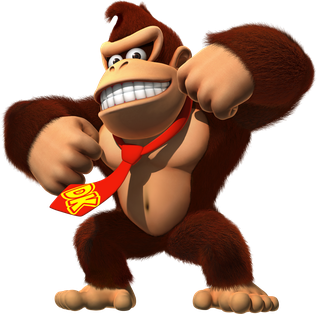| Name | Release date | Episodes | Region | Additional information |
|---|
The Legend of the Crystal Coconut (English)
Donkey Kong Country: La Légende de la noix de coco en cristal (French) | 1999 (Canada)
November 9, 1999 (USA) | 4 | VHS | Includes Legend of the Crystal Coconut, Bug a Boogie, Ape-Nesia, and Booty and the Beast edited together in a feature-length format. A French dub release for Canada was also released. |
| Donkey Kong Le Film! | TBA | 4 | VHS | French dubbed version of the Legend of the Crystal Coconut compilation feature, release for France. |
| ドンキーコング Vol. 1 (Donkey Kong Vol. 1) | June 21, 2000 | 3 | VHS | Includes Japanese dubbed versions of Episodes 1-3 (Bad Hair Day, Ape Foo Young and Booty and the Beast). |
| ドンキーコング Vol. 2 (Donkey Kong Vol. 2) | 3 | VHS | Includes Japanese dubbed versions of Episodes 4-6 (Barrel, Barrel... Who's Got the Barrel, Kong for a Day and Raiders of the Lost Banana). |
| ドンキーコング Vol. 3 (Donkey Kong Vol. 3) | 3 | VHS | Includes Japanese dubbed versions of Episodes 7-9 (From Zero to Hero, Buried Treasure and Cranky's Tickle Tonic). |
| ドンキーコング Vol. 4 (Donkey Kong Vol. 4) | August 19, 2000 | 3 | VHS | Includes Japanese dubbed versions of Episodes 10-12 (Orangutango, Double Date Trouble and The Curse of Kongo Bongo). |
| ドンキーコング Vol.5 (Donkey Kong Vol. 5) | 3 | VHS | Includes Japanese dubbed versions of Episodes 13-15 (Speed, Get a Life, Don't Save One and The Big Chill Out). |
| ドンキーコング Vol.6 (Donkey Kong Vol. 6) | 3 | VHS | Includes Japanese dubbed versions of Episodes 16-18 (To the Moon Baboon, I Spy with My Hairy Eye and Klump's Lumps). |
| ドンキーコング Vol.7 (Donkey Kong Vol. 7) | October 21, 2000 | 3 | VHS | Includes Japanese dubbed versions of Episodes 19-21 (Kong Fu, Bluster's Sale Ape-Stravaganza and Legend of the Crystal Coconut). |
| ドンキーコング Vol.8 (Donkey Kong Vol. 8) | 3 | VHS | Includes Japanese dubbed versions of Episodes 22-24 (Watch the Skies, Bug a Boogie and Baby Kong Blues). |
| ドンキーコング Vol.9 (Donkey Kong Vol. 9) | 3 | VHS | Includes Japanese dubbed versions of Episodes 25-27 (Ape-Nesia, A Thin Line Between Love & Ape and The Day the Island Stood Still). |
| ドンキーコング Vol.10 (Donkey Kong Vol. 10) | December 21, 2000 | 3 | VHS | Includes Japanese dubbed versions of Episodes 28-30 (Hooray for Holly-Kongo Bongo, The Kongo Bongo Festival of Lights and Speak No Evil, Dude). |
| ドンキーコング Vol.11 (Donkey Kong Vol. 11) | 3 | VHS | Includes Japanese dubbed versions of Episodes 31-33 (Monkey Seer, Monkey Do, Four Weddings and a Coconut and Vote of Kong-Fidence). |
| ドンキーコング Vol.12 (Donkey Kong Vol. 12) | 3 | VHS | Includes Japanese dubbed versions of Episodes 34-36 (Follow That Coconut, The Big Switch-A-Roo and Hunka Hunka Burnin' Bluster). |
| ドンキーコング Vol.13 (Donkey Kong Vol. 13) | 3 | VHS | Includes Japanese dubbed versions of Episodes 37-39 (Best of Enemies, Just Kidding and It's a Wonderful Life). |
| Donkey Kong Country - Vol. 1 | TBA | 4 | 4 | Includes Hooray for Holly-Kongo Bongo, The Kongo Bongo Festival of Lights, Speak No Evil, Dude and The Day the Island Stood Still. |
| The Kongo Bongo Festival of Lights | TBA | 2 | 4 | Includes The Kongo Bongo Festival of Lights and Hooray for Holly-Kongo Bongo. |
| Speak No Evil, Dude | TBA | 2 | 4 | Includes Speak No Evil, Dude and The Day the Island Stood Still. |
| Monkey Seer, Monkey Do | TBA | 2 | 4 | Includes Monkey Seer, Monkey Do and Four Weddings and a Coconut. |
| Bad Hair Day | June 6, 2005 | 4 | 2 | Includes Bad Hair Day, Ape Foo Young, Booty and the Beast and Barrel, Barrel... Who's Got the Barrel. |
| I Spy with My Hairy Eye | June 9, 2008 | 3 | 2 | Includes I Spy with My Hairy Eye, Baby Kong Blues and The Kongo Bongo Festival of Lights. |
| Raiders of the Lost Banana | August 3, 2009 | 5 | 2 | Includes Raiders of the Lost Banana, Barrel, Barrel... Who's Got the Barrel, Kong for a Day, From Zero to Hero and Buried Treasure. |
| He Came, He Saw, He Kong-quered | August 20, 2013 | 4 | 1 | Includes Bad Hair Day, Ape Foo Young, Booty and the Beast and Barrel, Barrel... Who's Got the Barrel. |
| Raiders of the Lost Banana | October 1, 2013 | 4 | 1 | Includes Raiders of the Lost Banana, Kong for a Day, From Zero to Hero and Buried Treasure. |
| Kong Fu | January 21, 2014 | 4 | 1 | Includes Kong Fu, Get a Life, Don't Save One, Cranky's Tickle Tonic and Orangutango. |
| The Legend of the Crystal Coconut | March 11, 2014 | 4 | 1 | Includes Legend of the Crystal Coconut, Bluster's Sale Ape-Stravaganza, Klump's Lumps and Speed. |
| The Complete First Season | May 12, 2015 | 26 | 1 | Includes all 26 episodes from season 1. |
| The Complete Second Season | TBA | 14 | 1 | Includes all 14 episodes from season 2. |














